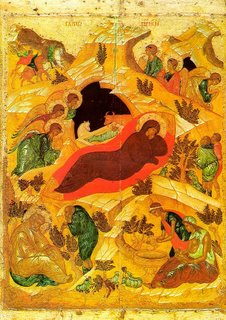 By Fr. John Parker
By Fr. John Parker(note: first in a series of four)
About seven hundred years ago, St. Andrei Rublev or one of his disciples painted perhaps the most memorable and beautiful icon of the Nativity of Christ. The 14th century icon is warped and cracked, but is in remarkable shape despite its age and history. It tells us, in earthen pigments bound to the gesso plaster, the story of the birth of Jesus, each facet of the good news surrounding the Virgin Mother Mary and the newborn Emmanuel—“God with us.” It teaches us with paint what we sing in one of the many traditional Orthodox hymns of the Nativity:
What shall we offer Thee, O Christ, Who for our sakes hast appeared on earth as man? Every creature made by Thee offers Thee thanks, The angels offer a hymn; The heavens a star; The wisemen gifts; the shepherds, their wonder; The earth, its cave; the wilderness, a manger. And we offer Thee a virgin mother. O pre-eternal God, have mercy on us!
During this season—as it is most widely known “Advent” (from the Latin, “coming”)—of preparation, please join me on a four Sunday journey around this holy marvel, on a theological pilgrimage to the birth of Jesus Christ.
We’ll start with the two scenes on the bottom. On the left sits an old man with an evident halo (a saint) confronted by a crooked fellow in a dark, hairy coat. St. Joseph, the foster-father of Jesus Christ is being tempted by the Devil to divorce Mary. Joseph is an old man, who, according to the tradition of the Church, was a widower obligated by his relationship to Mary to betroth her and care for her, who had been set apart as a temple virgin to bear the eternal Son of God in the flesh.
According to the Scriptures, “When [Jesus’] mother Mary had been betrothed to Joseph, before they came together she was found to be with child of the Holy Spirit; and her husband Joseph, being a just man and unwilling to put her to shame, resolved to send her away quietly. But as he considered this, behold, an angel of the Lord appeared to him in a dream, saying, ‘Joseph, son of David, do not fear to take Mary your wife, for that which is conceived in her is of the Holy Spirit; she will bear a son, and you shall call his name Jesus, for he will save his people from their sins’” (Matthew 1:18ff).
The temptation was to “send her away quietly” so as to not draw attention to a pregnant, unwedded teenager betrothed to an old man—even though Joseph and Mary never ‘knew’ one another, that is, they never slept together. Joseph may have had good intentions to protect young Mary, but God had other plans for him. He was told by an angel that this pregnancy was, in fact, a miracle and nothing to be ashamed of; rather, it was to be celebrated as the fulfillment of God’s promises, especially through the Prophet Isaiah, to save the world through a son, born of a virgin, in the lineage of King David.
If the images of St. Joseph and the Tempter narrate the miraculous birth of the divine Jesus Christ, the scene in the lower right shows the humanity of the birth of the Son of God. Jesus was not dropped onto the earth by an extraterrestrial ship, nor did he simply ‘appear’ as a created being. Rather, as the beginning of the redemption of all humanity and the whole world, he entered just as every single one of us does: through the womb. The birth of Christ is totally extraordinary in conception—“of the Holy Spirit” as the Angel told Joseph, and yet it is totally ordinary in its accomplishment. And so, here, we see two nursemaids doing what is done at every birth: receiving the newborn child and washing him to present to his mother. O strange wonder: God is made man. Heaven and earth meet. O come, o come Emmanuel!
Today the Virgin gives birth to the transcendent one, and the earth offers a cave to the unapproachable one! Angels with shepherds glorify Him! The wise men journey with the star! Since for our sake the eternal God was born as a little child!
Fr. John Parker is priest-in-charge of Holy Ascension Orthodox Church in I’On. He can be reached at frjohn@ocacharleston.org or by phone at 881-5010.
printed in the Post and Courier, December 3, 2006, and online at http://www.charleston.net/assets/webPages/departmental/news/default_pf.aspx?NEWSID=120991)
1 comment:
Father, bless,
Thank you for this wonderful article.
Post a Comment